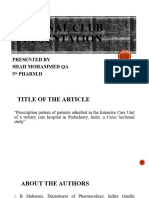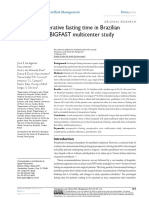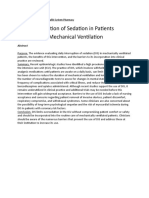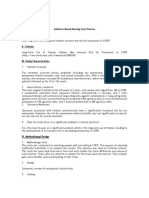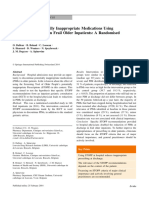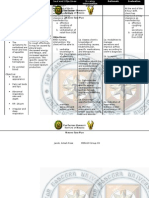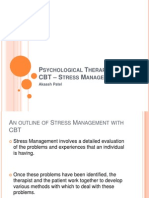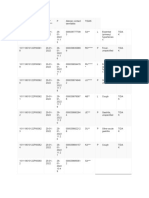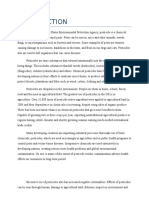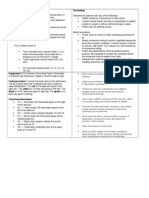Polypharmacy at Admission Prolongs Length of Hospitalization in Gastrointestinal Surgery Patients
Polypharmacy at Admission Prolongs Length of Hospitalization in Gastrointestinal Surgery Patients
Uploaded by
pfuni000227Copyright:
Available Formats
Polypharmacy at Admission Prolongs Length of Hospitalization in Gastrointestinal Surgery Patients
Polypharmacy at Admission Prolongs Length of Hospitalization in Gastrointestinal Surgery Patients
Uploaded by
pfuni000227Original Title
Copyright
Available Formats
Share this document
Did you find this document useful?
Is this content inappropriate?
Copyright:
Available Formats
Polypharmacy at Admission Prolongs Length of Hospitalization in Gastrointestinal Surgery Patients
Polypharmacy at Admission Prolongs Length of Hospitalization in Gastrointestinal Surgery Patients
Uploaded by
pfuni000227Copyright:
Available Formats
DOI: 10.1111/ggi.
14044
ORIGINAL ARTICLE
SOCIAL RESEARCH, PLANNING AND PRACTICE
Polypharmacy at admission prolongs length of hospitalization
in gastrointestinal surgery patients
Natsuki Abe, Takeyasu Kakamu, Tomohiro Kumagai, Tomoo Hidaka, Yusuke Masuishi,
Shota Endo, Hideaki Kasuga and Tetsuhito Fukushima
Department of Hygiene and Aim: Polypharmacy in elderly people is a social issue and has been reported to cause not
Preventive Medicine, Fukushima only drug adverse events, but also falls, dysfunction and cognitive decline. Those events may
trigger prolonged length of hospitalization. Therefore, the aim of this study was to investigate
Medical University School of
whether polypharmacy has a prolonging effect on hospitalization.
Medicine: 1 Hikarigaoka,
Fukushima, Japan Methods: The study subjects were 584 patients in a university hospital in Japan who had
been admitted for hepatectomy, pancreaticoduodenectomy, gastrectomy or colectomy, and to
whom clinical pathways had been applied. In this study, polypharmacy was defined as taking
Correspondence
five or more regular oral medications, and prolonged hospitalization was defined as hospitali-
Natsuki Abe MMSc
zation longer than that determined by the clinical pathway. Multiple logistic regression analy-
Department of Hygiene and sis was performed to investigate whether polypharmacy affects the length of hospitalization.
Preventive Medicine, Fukushima
Results: The subjects were 348 males and 236 females, mean ± SD age of 65.8 ± 12.9 years.
Medical University School of
Among all subjects, 228 (39.0%) were receiving polypharmacy at admission, and the num-
Medicine, Hikarigaoka
ber of patients with prolonged hospitalization was 262 (44.9%). Multiple logistic regression
1, Fukushima City 960-1295, analysis revealed that the following variables were significantly associated with prolonged
Japan. hospitalization; polypharmacy (odds ratio = 1.532; 95% confidence interval = 1.010–2.327),
Email: b1950737@fmu.ac.jp age 50–59; 2.971 (1.216–7.7758), age 60–69; 2.405 (1.059–5.909), organ pancreas; 0.298
(0.122–0.708), operation time ≥386 min; 2.050 (1.233–3.432), intraoperative bleeding vol-
Received: 5 May 2020 ume ≥401 mL; 2.440 (1.489–4.038), postoperative delirium; 2.395 (1.240–4.734), postopera-
tive infection; 10.715 (4.270–33.059).
Revised: 19 August 2020
Accepted: 2 September 2020 Conclusion: The current study revealed that polypharmacy at admission was an indepen-
dent factor for prolonged hospitalization. In future, measures against polypharmacy are
required, collaborating with outpatient clinics, family doctors and dispensing pharmacies.
Geriatr Gerontol Int ••; ••: ••–•• Geriatr Gerontol Int 2020; ••: ••–••.
Keywords: clinical pathway, elderly people, gastrointestinal surgery, polypharmacy, pro-
longed hospitalization.
Introduction the risk of adverse drug events increases when individuals take six
or more drugs concurrently.4 However, the problems caused by
Recently, polypharmacy in elderly people has become a serious polypharmacy include not only drug adverse events,5 but also inci-
issue. The Japan Geriatrics Society formulated Guidelines for Medi- dents such as falls,6,7 dysfunction and cognitive decline.8 Therefore,
cal Treatment and Its Safety in the Elderly in 2005 for the purpose it may be reasonable to assume that polypharmacy at admission
of improving pharmacotherapy safety in the elderly, because elderly may be associated with prolonged hospitalization.
people in general tend to have multiple diseases, thus requiring In regard to the effect of polypharmacy/medication on hospi-
polypharmacy.1 The latest version of these guidelines includes pre- talization, a previous study conducted in Europe revealed that use
scription optimization screening to avoid adverse drug events by of non-steroidal anti-inflammatory drugs for more than 6 days
polypharmacy, such as drug allergy and organ failure by metabolic before admission is associated with the length of hospitalization.9
and/or excretion abnormalities associated with age-related changes. Moreover, a previous study on patients undergoing total hip
According to the Ministry of Health, Labor and Welfare in Japan, arthroplasty10 reported that the prehospital dose is related to the
the number of prescribed medicines increases with age.2 In addi- length of hospitalization, and suggested that the number of drugs
tion, it has been reported that an average of six drugs is prescribed may affect the duration of hospitalization.
in elderly people when they have a complication of a chronic dis- However, there are few such studies in Japan, and therefore, in
ease and dementia, or have two or more chronic diseases.3 Further- the present study, we aimed to clarify whether polypharmacy at
more, past research on hospitalized elderly patients revealed that admission has a prolonging effect on hospitalization in Japan.
© 2020 The Authors. Geriatrics & Gerontology International | 1
published by John Wiley & Sons Australia, Ltd on behalf of Japan Geriatrics Society.
This is an open access article under the terms of the Creative Commons Attribution-NonCommercial-NoDerivs License, which permits use and distribution
in any medium, provided the original work is properly cited, the use is non-commercial and no modifications or adaptations are made.
N Abe et al.
Methods Evaluation of length of hospitalization
Patients were classified into two groups according to the length of
Research design hospitalization; regular and prolonged. The regular group was
This research was designed as a retrospective study. comprised of patients whose length of hospitalization was shorter
or the same as that determined by the clinical pathway. The pro-
longed group included patients whose length of hospitalization
was longer than that determined by the clinical pathway.
Study subjects
The subjects of this study were selected from 4132 patients who Definition of polypharmacy
were admitted to the gastrointestinal surgery ward of a university Currently, there is no clear definition of polypharmacy. In
hospital in Japan between November 1, 2013 and March Japan, studies on polypharmacy have reported that the risk of
31, 2017. Of these patients, 652 patients to whom clinical path- adverse drug events increases when the patient is taking six or
ways were applied and whose number of days in hospital could more drugs concurrently,4 and the occurrence of falls is
be identified were extracted. Clinical pathways used in this study increased with taking five or more drugs concurrently.6 Based
were those for gastrectomy, colectomy, colostomy, proctectomy, on those results, the medical service fee system in Japan defines
hepatectomy and pancreaticoduodenectomy (Table 1). polypharmacy as taking six or more drugs concurrently, whereas
68 patients were excluded due to drop out from the clinical path- academic studies in Japan have commonly defined it as more than
ways. Finally, 584 subjects were enrolled in the current five or six drugs. On the other hand, in European countries and the
study (Fig. 1). United States, many studies define polypharmacy as the concurrent
use of five or more drugs, in light of a report by Gnjidic et al. that
vulnerability, dysfunction, cognitive decline and death of the elderly
increase when they are taking five or more drugs.8 In the present
Research items
study, we defined the polypharmacy group as subjects who
From medical records, we collected data on age, gender, residence were taking five or more regular oral drugs at admission and the
(residence in a municipality where a hospital is located or not), non-polypharmacy group for all others.
presence or absence of cancer, multimorbidity, operative proce-
dure, operation time (min), intraoperative bleeding volume (mL),
Analysis
presence or absence of physical paralysis, hospitalization longer
than or the same length as that determined by the clinical path- Continuous variables (age, operation time, intraoperative bleeding
way, medication at admission, family structure, course during hos- volume and multimorbidity), are described as median (25–75th
pitalization such as malnutrition at admission, postoperative percentile) and number (%) for categorical variables. To compare
course, activities of daily living, medication management status each categorical variable between two groups, we used the Mann–
and family support status. Whitney U-test and chi-squared test.
The length of hospital stay in the clinical pathway is deter- Age (years) was classified into seven groups (20–29, 30–39,
mined based on the Diagnosis Procedure Combination/Per-Diem 40–49, 50–59, 60–69, 70–79 and ≥80 years). The operation time,
Payment System by the in-hospital review committee. intraoperative bleeding volume and multimorbidity were each
Table 1 Study subjects with clinical pathways
Name of clinical pathway Hospitalization days Disease
Stomach
Gastrectomy 10 Gastric cancer, Barrett’s
esophagusGIST†
Colon
Laparoscopic colectomy 10 Colon cancer Gastrointestinal
Laparotomy colectomy 15 perforation Ileus Ulcerative
Colostomy 18 colitisGIST†Crohn’s disease
adenomatous polyposis
Rectum
Proctectomy 17 GIST†Rectal prolapse, anal canal cancer
Liver
Hepatectomy (segmentectomy, not 10 Liver cancer, hepatic hemangiomaBile
hepatic cirrhosis) duct cancerLiver donor
Hepatectomy (two or larger 15 Liver cancer Metastatic liver cancer
segmentectomy, hepatic cirrhosis)
Pancreas
Pancreaticoduodenectomy 23 Pancreatic cancer Duodenal
cancerIntraductal papillary mucinous
neoplasmPancreatic neuroendocrine
tumor
†
Gastrointestinal stromal tumor.
2 | © 2020 The Authors. Geriatrics & Gerontology International
published by John Wiley & Sons Australia, Ltd on behalf of Japan Geriatrics Society.
Prolonged hospitalization by polypharmacy
Figure 1 Flow chart of criteria regarding enrollment and exclusion of study participants.
classified into two groups at the 75th percentile: for operation were used for explanation, and only those who agreed to the
time, the ≤385-min and ≥386-min groups; for intraoperative participation were included.
bleeding volume, the ≤400-mL and ≥401-mL groups; and for
multimorbidity, the ≤2 and ≥3.
Confounding factors were age, gender, target organs, cancer, Results
operation time, intraoperative bleeding volume, multimorbidity,
postoperative infection, postoperative delirium and malnutrition at The study population comprised 584 patients, 348 males and
admission. 236 females, with a mean ± SD age of 65.8 ± 12.9 years. Of all
To investigate whether polypharmacy affects the length of hos- patients, 228 (39.0%) were categorized into the polypharmacy
pitalization, multiple logistic regression analysis was performed. In group. Regarding the length of hospitalization, 322 (55.1%) were
this analysis, the age group 40–49 and the stomach were set as ref- categorized into the regular group and 262 (44.9%) into the
erences, because the numbers of subjects who were in the regular prolonged group.
group were highest in such categories. The objective variable was As shown in Table 2, the results of a comparison of patient
length of hospitalization, and the explanatory variables were poly- characteristics between the polypharmacy and non-polypharmacy
pharmacy and 10 other factors that may affect the length of hospi- groups showed age, prevalence of cancer, malnutrition at admis-
talization: age, gender, target organs, operation time, intraoperative sion, prolonged hospitalization, multimorbidity, hypertension,
bleeding volume, cancer, multimorbidity, postoperative infection, diabetes, respiratory disease, heart disease, cerebrovascular dis-
postoperative delirium and malnutrition at admission. Odds ratio ease, motor disorder, neuropsychiatric disorders, postoperative
(OR) and 95% confidence interval (95% CI) were calculated. It is delirium and physical paralysis were significantly higher in the
notable that the explanatory variables consisted of factors that were polypharmacy group (P < 0.001, P = 0.022, P < 0.001, P = 0.003,
considered related to outcome, based on the findings of previous P < 0.001, P < 0.001, P < 0.001, P = 0.009, P < 0.001, P < 0.001,
studies and clinical judgment. P = 0.023, P < 0.001, P < 0.001, P = 0.005, respectively).
For statistical analysis, we used R 3.5.2. As shown in Table 3, the results of logistic regression analysis
analyzing factors that affected the length of hospitalization indi-
cated that polypharmacy significantly prolonged hospitalization
(OR = 1.532; 95% CI = 1.010–2.327). As for the rest, the following
Ethics committee approval
factors significantly increased the length of hospitalization
This research was approved by the Fukushima Medical University (OR [95% CI]): operation time ≥386 min, 2.050 (1.233–3.432),
Ethics Committee (approval number: 2456). Informed consent and intraoperative bleeding volume ≥401 mL, 2.440
was obtained in the following two ways, according to the date of (1.489–4.038). In addition, the length of hospitalization was signif-
admission to hospital, i.e., (i) for subjects who were admitted to icantly longer in the following categories compared with the refer-
hospital by June 30, 2016, the scheme of our research was dis- ences (OR [95% CI]): 50–59 age group, 2.971 (1.216–7.758);
closed on our website, instead of obtaining written informed con- 60–69 age group, 2.405 (1.059–5.909); with postoperative delir-
sent, and (ii) for those who were admitted from July 1, 2016 ium, 2.395 (1.240–4.734); with postoperative infection, 10.715
onwards, the updated criteria and procedure of the committee (4.270–33.059).
© 2020 The Authors. Geriatrics & Gerontology International | 3
published by John Wiley & Sons Australia, Ltd on behalf of Japan Geriatrics Society.
N Abe et al.
Table 2 Comparison between polypharmacy and non-polypharmacy groups
n = 584
Polypharmacy P-value
Polypharmacy(n = 228) Non-polypharmacy (n = 356)
Age 72.0 (66.0–79.0) 63.0 (55.8–72.0) P < 0.001*†
Gender (male) 136 (59.6) 212 (59.6) 0.98‡
Organ
Stomach 42 (18.4) 103 (28.9)
Colon 62 (27.2) 78 (21.9)
Rectum 27 (11.8) 33 (9.3)
Liver 42 (18.4) 77 (21.6)
Pancreas 22 (9.6) 22 (6.2)
Bile duct 19 (8.3) 27 (7.6)
Duodenum 12 (5.3) 11 (3.1)
Other 2 (0.9) 5 (1.4) 0.057‡
Cancer 196 (86.0) 279 (78.4) 0.022*‡
Malnutrition at admission 72 (31.6) 56 (15.7) P < 0.001*‡
Prolonged hospitalization 120 (52.6) 142 (39.9) 0.003*‡
Operation time (min) 286.5 (203.8–410.8) 298.0 (202.0–380.2) 0.93†
Intraoperative bleeding volume (mL) 110.0 (20.0–382.5) 100.0 (20.0–402.5) 0.93†
Multimorbidity 2.00 (1.00–3.00) 1.00 (0.00–2.00) P < 0.001*‡
Past medical history
Hypertension 115 (50.4) 85 (23.9) P < 0.001*‡
Diabetes 85 (37.3) 31 (8.7) P < 0.001*‡
Respiratory disease 21 (9.2) 14 (3.9) 0.009*‡
Heart disease 61 (26.8) 30 (8.4) P < 0.001*‡
Cerebrovascular disease 24 (10.5) 7 (2.0) P < 0.001*‡
Motor disorder 27 (11.8) 23 (6.5) 0.023*‡
Neuropsychiatric disorder 17 (7.5) 2 (0.6) P < 0.001*‡
Postoperative complication
Postoperative infection 16 (7.0) 29 (8.1) 0.62‡
Obstruction 14 (6.1) 15 (4.2) 0.3‡
Postoperative delirium 38 (16.7) 19 (5.3) P < 0.001*‡
Postoperative IVH§ 34 (14.9) 41 (11.5) 0.23‡
Early ambulation 200 (87.7) 319 (89.6) 0.48‡
Alone 33 (14.5) 46 (12.9) 0.6‡
Residence 192 (84.2) 285 (80.1) 0.21‡
Physical paralysis 26 (11.4) 18 (5.1) 0.005*‡
Median (range), n (%).
*P < 0.05.
†
Mann–Whitney U-test.
‡
Chi-squared test.
§
Intravenous Hyperalimentation.
Discussion hospitalization for a reason other than their chronic diseases, the
medical care being administered should be considered as part of,
In the present study, we revealed that polypharmacy was an inde- not independent from their daily life.
pendent factor that prolonged hospitalization. In recent years, Generally, Japanese people tend to perceive security and satisfac-
polypharmacy has attracted attention in terms of adverse drug tion when their drugs are prescribed. In addition, elderly people
events and medical costs, leading to many studies being con- tend to receive polypharmacy unconsciously, because they often
ducted on polypharmacy. These studies have revealed various have a high prevalence of complications of multiple diseases.1 Physi-
complications due to polypharmacy, such as adverse drug cians, nurses and pharmacists provide patient compliance instruc-
events,4,5 falls7,11 and increased mortality.12,13 However, to our tions to patients who receive medical treatment. These instructions
knowledge, few studies have predicted the length of hospitaliza- are implemented for both inpatients and outpatients to explain the
tion using patient characteristics and medical history. In the cur- safety and efficacy of each drug, and to make sure the patient under-
rent study, polypharmacy at admission was identified as a stands the need to take them correctly. However, polypharmacy can
predictor of prolonged hospitalization. Importantly, polypharmacy lead to a decrease in medication adherence.14,15 In particular, elderly
is not only influenced by various factors during hospital stay, but people may require increased time to acquire medication manage-
also depends on the prehospital treatment situation. Our results ment skills due to age-related decline in cognitive function and
suggested that for patients undergoing surgery or during adaptive ability.16 If patients with polypharmacy are admitted to
4 | © 2020 The Authors. Geriatrics & Gerontology International
published by John Wiley & Sons Australia, Ltd on behalf of Japan Geriatrics Society.
Prolonged hospitalization by polypharmacy
Table 3 Results of logistic regression analysis
(AIC = 742.83) n = 584
†
Number Crude OR (95% CI) Multivariate-adjusted OR (95% CI)
Polypharmacy
Without 356 1.000 (reference) 1.000 (reference)
With 228 1.674 (1.198–2.345) 1.532 (1.010–2.327)
Age (years)
20–29 9 2.133 (0.462–9.446) 2.769 (0.522–14.337)
30–39 17 2.370 (0.737–7.691) 2.963 (0.788–11.164)
40–49 44 1.000 (reference) 1.000 (reference)
50–59 78 2.286 (1.047–5.223) 2.971 (1.216–7.758)
60–69 191 2.138 (1.063–4.555) 2.405 (1.059–5.909)
70–79 170 2.261 (1.116–4.845) 2.249 (0.972–5.609)
≤80 75 2.889 (1.318–6.635) 2.583 (0.985–7.179)
Gender
Male 348 1.000 (reference) 1.000 (reference)
Female 236 0.752 (0.537–1.049) 0.929 (0.636–1.357)
Organ
Stomach 145 1.000 (reference) 1.000 (reference)
Colon 140 1.503 (0.938–2.417) 1.436 (0.852–2.428)
Rectum 60 1.475 (0.800–2.714) 1.039 (0.515–2.077)
Liver 119 1.139 (0.692–1.875) 0.805 (0.452–1.424)
Pancreas 44 1.167 (0.580–2.314) 0.298 (0.122–0.708)
Bile duct 46 3.483 (1.751–7.187) 1.675 (0.757–3.762)
Duodenum 23 2.621 (1.077–6.683) 0.928 (0.321–2.705)
Others 7 1.264 (0.241–5.940) 1.265 (0.219–6.624)
Operation time (min)
≤385 439 1.000 (reference) 1.000 (reference)
≥386 145 2.263 (1.546–3.332) 2.050 (1.233–3.432)
Intraoperative bleeding volume (mL)
≤400 443 1.000 (reference) 1.000 (reference)
≥401 141 2.281(1.553–3.373) 2.440 (1.489–4.038)
Cancer
Without 109 1.000 (reference) 1.000 (reference)
With 475 1.091 (0.718–1.666) 0.885 (0.534–1.475)
Postoperative delirium
Without 527 1.000 (reference) 1.000 (reference)
With 57 2.705 (1.538–4.910) 2.395 (1.240–4.734)
Postoperative infection
Without 539 1.000 (reference) 1.000 (reference)
With 45 11.423 (4.860–33.513) 10.715 (4.270–33.059)
Multimorbidity
≤2 472 1.000 (reference) 1.000 (reference)
≥3 112 1.350 (0.893–2.042) 1.050 (0.629–1.746)
Malnutrition on admission
Without 456 1.000 (reference) 1.000 (reference)
With 128 1.728 (1.166–2.572) 1.440 (0.924–2.247)
Multivariate-adjusted odds ratio (OR) adjusted all variables in table.
CI, confidence interval.
hospital, their medications are scheduled and administered by their In Japan, shortening the length of hospitalization is promoted
attending nurses. At discharge, the patients are required to attain by the standardization of medical care and reform of the medical
self-management of medication. Otherwise, hospitalization may be service system. In 2003, a comprehensive evaluation system for
prolonged. It may be difficult for elderly people to acquire medica- diagnosis and treatment fees, the Diagnosis Procedure Combina-
tion management skills within a limited hospitalization period with tion/Per-Diem Payment System, was introduced, after which the
the reasons mentioned above. Furthermore, medication manage- use of clinical pathways increased dramatically. The clinical path-
ment becomes more difficult in cases of elderly individuals who are way is a standardized care plan, including goals, evaluation, and
taking polypharmacy, who use complicated dosing methods, and recording of both patient conditions and treatment.17 Because of
who have a lack of support. It is assumed that the length of hospital- the broad use of the clinical pathway, the average length of hospi-
ization may be extended in such cases due to the inability to manage talization in acute care hospitals in Japan decreased from 20.3 days
the medication, even if the treatment is completed. in 2004, to 16.3 days in 2016. However, this length of stay is still
© 2020 The Authors. Geriatrics & Gerontology International | 5
published by John Wiley & Sons Australia, Ltd on behalf of Japan Geriatrics Society.
N Abe et al.
the longest among major developed countries, where the average 3 Ministry of Health LaW. Ministry of Health, Labour and Welfare 2017.
hospital stay was 9.4 days in Russia, 7.5 days in Germany, 7.3 days 4 Kojima T, Akishita M, Kameyama Y et al. High risk of adverse drug
reactions in elderly patients taking six or more drugs: analysis of inpa-
in Korea, 6.9 days in Italy and 6.0 days in Britain.18 tient database. Geriatr Gerontol Int 2012; 12: 761–762.
Prolonged hospitalization is associated with many problems, 5 Field TS, Gurwitz JH, Avorn J et al. Risk factors for adverse drug events
such as increases in healthcare costs,19 onset of disuse syndrome20 among nursing home residents. Arch Intern Med 2001; 161: 1629–1634.
and risk of dementia in the elderly.21,22 Although improvement to 6 Kojima T, Akishita M, Nakamura T et al. Polypharmacy as a risk for fall
occurrence in geriatric outpatients. Geriatr Gerontol Int 2012; 12:
decrease these incidences may contribute to the shortening of
425–430.
hospitalization length, it is difficult to predict such incidences. 7 Dhalwani NN, Fahami R, Sathanapally H, Seidu S, Davies MJ,
Therefore, factors that predict such incidences are required for Khunti K. Association between polypharmacy and falls in older adults: a
the shortening of hospitalization. longitudinal study from England. BMJ Open 2017; 7: e016358.
8 Gnjidic D, Hilmer SN, Blyth FM et al. Polypharmacy cutoff and out-
An increase in the length of hospitalization increases medical
comes: five or more medicines were used to identify community-
expenses.19 Since the FY2016 Revision of Reimbursement of dwelling older men at risk of different adverse outcomes. J Clin Epidemiol
Medical Fees in Japan,23 most medical institutions have been 2012; 65: 989–995.
allowed to charge additional medical fees when the number of 9 Kotsiou OS, Zarogiannis SG, Gourgoulianis KI. Prehospital NSAIDs
drugs prescribed for the patient is six or more before admission use prolong hospitalization in patients with pleuro-pulmonary infection.
Respir Med 2017; 123: 28–33.
and is reduced by two or more at discharge. However, while pro- 10 Dietrich M, Zingg PO, Egbring M, Kamath AF, Dora C. Pre-hospital
moting the shortening of hospitalization, reduction of the number medications in total hip arthroplasty: risk factors for poor outcomes.
of prescribed drugs is assumed to be difficult. Therefore, a method Hip Int 2015; 25: 215–220.
for polypharmacy prevention, collaborating with outpatient 11 Borenstein J, Aronow HU, Bolton LB, Choi J, Bresee C,
Braunstein GD. Early recognition of risk factors for adverse outcomes
clinics, family doctors and regional dispensing pharmacies is during hospitalization among Medicare patients: a prospective cohort
required. In addition, the finding that polypharmacy prolongs hos- study. BMC Geriatr 2013; 13: 72.
pitalization in the current study suggests that further intervention 12 Choi KS, Jeong YM, Lee E et al. Association of pre-operative medica-
is required by outpatient clinics for polypharmacy prevention. tion use with post-surgery mortality and morbidity in oncology patients
receiving comprehensive geriatric assessment. Aging Clin Exp Res 2018;
In the present study, the length of hospitalization was extended
30: 1177–1185.
whose operation time was ≥386 min, whose intraoperative bleed- 13 Leelakanok N, Holcombe AL, Lund BC, Gu X, Schweizer ML. Associ-
ing volume was ≥401 mL, and who developed postoperative delir- ation between polypharmacy and death: a systematic review and meta-
ium or postoperative infection. These results are consistent with analysis. J Am Pharm Assoc 2017; 57: 729-38.e10.
14 Osterberg L, Blaschke T. Adherence to medication. N Engl J Med 2005;
those of previous studies.24–26
353: 487–497.
This study has some limitations. First, we did not acquire 15 Pasina L, Brucato AL, Falcone C et al. Medication non-adherence
information of administered medical drugs although they may among elderly patients newly discharged and receiving polypharmacy.
have affected the hospitalization duration. In a future study, such Drugs Aging 2014; 31: 283–289.
information should be included in the analysis of the relationship 16 Hishikawa N, Fukui Y, Sato K et al. Characteristic features of cognitive,
affective and daily living functions of late-elderly dementia. Geriatr
between polypharmacy and hospitalization duration. Second, this Gerontol Int 2016; 16: 458–465.
study was conducted in an abdominal surgery ward in one hospi- 17 Pathway JSfC. Definition of Clinical Pathway.
tal. Whether these findings are adopted by other hospitals or other 18 OECD: Length of hospital stay.
disease conditions such as thoracic surgery or orthopedic surgery, 19 Ministry of Health LaW. Ministry of Health, Labour and Welfare. 2006.
20 Sonoda S. Immobilization and disuse syndrome. Jpn J Rehabil Med 2015;
warrants more study in the future. 52: 265–271.
In the current study, we found that polypharmacy prolonged 21 Ehlenbach WJ, Hough CL, Crane PK et al. Association between acute
hospitalization. Our study results suggest that collaboration care and critical illness hospitalization and cognitive function in older
among outpatient clinics, family doctors, and dispensing pharma- adults. JAMA 2010; 303: 763–770.
22 Wilson RS, Hebert LE, Scherr PA, Dong X, Leurgens SE, Evans DA.
cies may be required to ensure that patients follow medication
Cognitive decline after hospitalization in a community population of
instructions and to adjust polypharmacy before admission. This older persons. Neurology 2012; 78: 950–956.
may enable scheduled discharge and optimal outcome. 23 Ministry of Health LaW. Health and Medical Services 2017.
24 Andersen K, Thastum M, Norholt SE, Blomlof J. Relative blood loss
and operative time can predict length of stay following orthognathic
Acknowledgements surgery. Int J Oral Maxillofac Surg 2016; 45: 1209–1212.
25 Emond M, Boucher V, Carmichael PH et al. Incidence of delirium in
The authors are deeply grateful to the patients and medical staff at the Canadian emergency department and its consequences on hospital
length of stay: a prospective observational multicentre cohort study.
Fukushima Medical University Hospital for their help in this BMJ Open 2018; 8: e018190.
research. 26 Kusachi S, Kashimura N, Konishi T et al. Length of stay and cost for
surgical site infection after abdominal and cardiac surgery in Japanese
hospitals: multi-center surveillance. Surg Infect (Larchmt) 2012; 13:
Disclosure statement 257–265.
The authors declare no conflict of interest.
How to cite this article: Abe N, Kakamu T, Kumagai T,
References
et al. Polypharmacy at admission prolongs length of hospi-
1 Society TJG. Guidelines for Medical Treatment and its Safety in the Elderly talization in gastrointestinal surgery patients. Geriatr.
2015 (in Japanese). Tokyo: Medical View Co, Ltd, 2015; 2015.
Gerontol. Int. 2020;1–6. https://doi.org/10.1111/ggi.14044
2 Ministry of Health LaW. Ministry of Health, Labour and Welfare Statis-
tics of Medical Care Activities in Public Health Insurance. 2016.
6 | © 2020 The Authors. Geriatrics & Gerontology International
published by John Wiley & Sons Australia, Ltd on behalf of Japan Geriatrics Society.
You might also like
- The Result of Inpatient Lengths of Stay On Hospital Readmission RatesDocument8 pagesThe Result of Inpatient Lengths of Stay On Hospital Readmission Ratesapi-309980971No ratings yet
- s41598 021 88207 6 PDFDocument8 pagess41598 021 88207 6 PDFManuel ArenasNo ratings yet
- 6. Template JHS 2024 Erlinda Surya Lita ENG (Norman UNA) 815-828Document14 pages6. Template JHS 2024 Erlinda Surya Lita ENG (Norman UNA) 815-828Norman DyantoNo ratings yet
- 2019 - Pediatric Critical Care - Sedative and Analgesic Drug Rotation Protocol in Critically Ill Children With Prolonged SedationDocument7 pages2019 - Pediatric Critical Care - Sedative and Analgesic Drug Rotation Protocol in Critically Ill Children With Prolonged Sedationgabriela1912No ratings yet
- Jurnal ApendiktomyDocument6 pagesJurnal ApendiktomySiti HosimahNo ratings yet
- Fmed 09 908100Document9 pagesFmed 09 908100JD PrasetyonoNo ratings yet
- Jurnal 1Document7 pagesJurnal 1Deski MadeNo ratings yet
- Foreign Body Ingestion and Food ImpactionDocument7 pagesForeign Body Ingestion and Food ImpactionVENI ROSITA DEWINo ratings yet
- Publication__1 (1)Document4 pagesPublication__1 (1)krishnendu mondalNo ratings yet
- Hospital Exercise McCullegh 2020Document11 pagesHospital Exercise McCullegh 2020Ai NurfaiziyahNo ratings yet
- Iatrogenic Withdrawal Syndrome in Specialty Pediatric Critical CareDocument5 pagesIatrogenic Withdrawal Syndrome in Specialty Pediatric Critical Carefuka priesleyNo ratings yet
- Infantile Hypertrophic Pyloric Stenosis at A TertiDocument7 pagesInfantile Hypertrophic Pyloric Stenosis at A TertiVașadi Razvan CristianNo ratings yet
- s13054 022 03974 6Document10 pagess13054 022 03974 6fernanda contrerasNo ratings yet
- Presentation RTA, DM, Rheumatoid ArthritisDocument26 pagesPresentation RTA, DM, Rheumatoid ArthritisShah MohammedNo ratings yet
- Opioid Tapering Practices-Time For ReconsiderationDocument2 pagesOpioid Tapering Practices-Time For ReconsiderationJeffrey XieNo ratings yet
- Actual Preoperative Fasting Time in Brazilian Hospitals: The Bigfast Multicenter StudyDocument6 pagesActual Preoperative Fasting Time in Brazilian Hospitals: The Bigfast Multicenter StudySurya BugisNo ratings yet
- Epidemiology of Secondary Peritonitis: Analysis of 545 CasesDocument6 pagesEpidemiology of Secondary Peritonitis: Analysis of 545 CasesIntan KarmilaNo ratings yet
- Enhanced Recovery After Surgery For Cesarean Delivery Decreases Length of Hospital Stay and Opioid Consumption: A Quality Improvement InitiativeDocument9 pagesEnhanced Recovery After Surgery For Cesarean Delivery Decreases Length of Hospital Stay and Opioid Consumption: A Quality Improvement Initiativedina istianaNo ratings yet
- Long-Stay of PICU in SepsisDocument6 pagesLong-Stay of PICU in SepsisSanti IskandarNo ratings yet
- Endocarditis: Un Estudio de Cohorte Multicéntrico, RetrospectivoDocument8 pagesEndocarditis: Un Estudio de Cohorte Multicéntrico, RetrospectivoMelendi NavarroNo ratings yet
- 8Smartphone enabled video-observed versus directly observed treatment for tuberculosis a multicentre, analyst-blinded, randomised, controlled superiority trialDocument9 pages8Smartphone enabled video-observed versus directly observed treatment for tuberculosis a multicentre, analyst-blinded, randomised, controlled superiority trialcuchineseomgNo ratings yet
- Bedside Assessment of Swallowing: A Useful Screening Tool For Dysphagia in An Acute Geriatric WardDocument6 pagesBedside Assessment of Swallowing: A Useful Screening Tool For Dysphagia in An Acute Geriatric WardAulia RaysNo ratings yet
- Antibiotic Prophylaxis in Orthognathic Surgery - An Overview of Systematic ReviewsDocument12 pagesAntibiotic Prophylaxis in Orthognathic Surgery - An Overview of Systematic ReviewsBruno GuardieiroNo ratings yet
- What Will Keep Me Coming Back To The Clinic FactorDocument4 pagesWhat Will Keep Me Coming Back To The Clinic Factor052591No ratings yet
- NIH Public Access: Author ManuscriptDocument11 pagesNIH Public Access: Author ManuscriptmartingomezrNo ratings yet
- PIIS2213260023004186Document11 pagesPIIS2213260023004186teresa mendozaNo ratings yet
- Patient Safety During Sedation by Anesthesia ProfeDocument8 pagesPatient Safety During Sedation by Anesthesia ProfeIsmar MorenoNo ratings yet
- (Inglês) Tomada de Decisão Clínica Usando Um Protocolo de Avaliação Da Função de Deglutição Após Pneumonia AspirativaDocument8 pages(Inglês) Tomada de Decisão Clínica Usando Um Protocolo de Avaliação Da Função de Deglutição Após Pneumonia Aspirativagabriela vazNo ratings yet
- GLZ 166Document6 pagesGLZ 166tia tamaraNo ratings yet
- Complicaciones en Sedacion Endovenosa en Tratamientos Dentales en Pacientes Con Discapacidad Mental 2015Document6 pagesComplicaciones en Sedacion Endovenosa en Tratamientos Dentales en Pacientes Con Discapacidad Mental 2015Carlos AlfaroNo ratings yet
- Patient Preferences For Physician Attire: A Multicenter Study in JapanDocument7 pagesPatient Preferences For Physician Attire: A Multicenter Study in JapanIra KusumawardaniNo ratings yet
- A Survey of Pain Management and Procedural Sedation Practices by Pediatric Hematologyoncology Practitioners in ChinaDocument13 pagesA Survey of Pain Management and Procedural Sedation Practices by Pediatric Hematologyoncology Practitioners in ChinaScivision PublishersNo ratings yet
- Daily Interruption of Sedation in Patients Treated With Mechanical VentilationDocument4 pagesDaily Interruption of Sedation in Patients Treated With Mechanical VentilationMark_LiGx_8269No ratings yet
- Research Paper On PolypharmacyDocument5 pagesResearch Paper On Polypharmacyefj02jba100% (1)
- Pharmacy-09-00122Document14 pagesPharmacy-09-00122JuliaNo ratings yet
- HepatologyDocument3 pagesHepatologywaldirNo ratings yet
- Characteristics of Medication-Induced Xerostomia and Effect of TreatmentDocument14 pagesCharacteristics of Medication-Induced Xerostomia and Effect of TreatmentRobertoNo ratings yet
- Evidence Based Nursing - Pneumonia WordDocument3 pagesEvidence Based Nursing - Pneumonia WordhahahahaaaaaaaNo ratings yet
- Early Intensive Care Unit Mobility Therapy in The Treatment of Acute Respiratory FailureDocument6 pagesEarly Intensive Care Unit Mobility Therapy in The Treatment of Acute Respiratory FailureTakashi NakamuraNo ratings yet
- Short and Long-Term Outcomes After Surgical Procedures Lasting For More Than Six HoursDocument8 pagesShort and Long-Term Outcomes After Surgical Procedures Lasting For More Than Six HoursDickyNo ratings yet
- B5381002 PLS FinalDocument8 pagesB5381002 PLS FinalJonas SaldanhaNo ratings yet
- Artigo Internacional Potencial OmissãoDocument6 pagesArtigo Internacional Potencial OmissãoRaquel AndradeNo ratings yet
- JURNALDocument11 pagesJURNALdiklat.rsakademis2024No ratings yet
- Efficacy of Propranolol Between 6 and 12 Months of Age in High Risk Infantile HemangiomDocument10 pagesEfficacy of Propranolol Between 6 and 12 Months of Age in High Risk Infantile HemangiomNoviaNo ratings yet
- Successful Management of Hypothyroidism in Gastric Outlet Obstruction Using Levothyroxine Rectal Enemas: A Case ReportDocument3 pagesSuccessful Management of Hypothyroidism in Gastric Outlet Obstruction Using Levothyroxine Rectal Enemas: A Case ReportShannya PuaNo ratings yet
- Proactive Integrated Consultation Liaison PsychiatDocument12 pagesProactive Integrated Consultation Liaison PsychiatDragutin PetrićNo ratings yet
- PJMS 34 959Document5 pagesPJMS 34 959Husni FaridNo ratings yet
- Medication Incompatibility in Intravenous Lines in A Paediatric Intensive Care Unit (PICU) of Indonesian Hospital (Kel.8)Document11 pagesMedication Incompatibility in Intravenous Lines in A Paediatric Intensive Care Unit (PICU) of Indonesian Hospital (Kel.8)Rotama GurningNo ratings yet
- Point-Of-Care Gastric Ultrasound and Aspiration Risk Assessment - A Narrative Review PDFDocument12 pagesPoint-Of-Care Gastric Ultrasound and Aspiration Risk Assessment - A Narrative Review PDFJohana FuentesNo ratings yet
- Cmar 14 2399Document9 pagesCmar 14 2399Paloma LizardiNo ratings yet
- J Jmig 2018 06 008Document6 pagesJ Jmig 2018 06 008Sulaeman Andrianto SusiloNo ratings yet
- 3 DC 3Document8 pages3 DC 3astutikNo ratings yet
- JNM 21 414Document9 pagesJNM 21 414angelNo ratings yet
- Feres Et Al., 20009Document11 pagesFeres Et Al., 20009Leandro PeraltaNo ratings yet
- Low Disclosure of PrEP Nonadherence and HIV Risk Behaviors Associated With Poor HIV PrEP Adherence in The HPTN 067: ADAPT StudyDocument17 pagesLow Disclosure of PrEP Nonadherence and HIV Risk Behaviors Associated With Poor HIV PrEP Adherence in The HPTN 067: ADAPT StudycapawatywidyNo ratings yet
- Dalleur 2014Document8 pagesDalleur 2014nguyenphuongkdydsNo ratings yet
- The Extent of Knowledge and Participation of The Staff Nurses On The Visual Infusion Phlebitis Program of Saint Anthony College HospitalDocument89 pagesThe Extent of Knowledge and Participation of The Staff Nurses On The Visual Infusion Phlebitis Program of Saint Anthony College HospitalWinj BudayNo ratings yet
- Piaa 055Document7 pagesPiaa 055m6ztfk4nsvNo ratings yet
- Bmj-2021-069211.full Reduce Unnecessary Use of Proton Pump InhibitorsDocument7 pagesBmj-2021-069211.full Reduce Unnecessary Use of Proton Pump InhibitorsYo MeNo ratings yet
- Top Trials in Gastroenterology & HepatologyFrom EverandTop Trials in Gastroenterology & HepatologyRating: 4.5 out of 5 stars4.5/5 (7)
- Entrance Exam 2023 ClsuDocument32 pagesEntrance Exam 2023 Clsukevin kovhgNo ratings yet
- Task Sheet and Topics For DioramaDocument1 pageTask Sheet and Topics For Dioramaapi-288536389No ratings yet
- Ap Pre TestDocument8 pagesAp Pre TestSyliminusNo ratings yet
- Nursing Care PlanDocument9 pagesNursing Care PlanjmichaelaNo ratings yet
- Teeth AssemblyDocument4 pagesTeeth AssemblyWi Mae RiNo ratings yet
- CBT - Stress ManagementDocument8 pagesCBT - Stress ManagementakaashpatelNo ratings yet
- Written ReportDocument7 pagesWritten ReportChello Ann AsuncionNo ratings yet
- Chapter 1 - Understanding Disability & VulnerabilityDocument38 pagesChapter 1 - Understanding Disability & VulnerabilityNaol ZelekeNo ratings yet
- European Secrets To Heal Your Liver Gallbladder Ebook 609Document22 pagesEuropean Secrets To Heal Your Liver Gallbladder Ebook 609LangMarcNo ratings yet
- Gene Transfer Questions-2021Document4 pagesGene Transfer Questions-2021Kaif AliNo ratings yet
- 12th MDCON Madam MiniDocument20 pages12th MDCON Madam MiniMinnie PamutanNo ratings yet
- Operational Guidelines RBSKDocument43 pagesOperational Guidelines RBSKanunad100% (1)
- Project Hospital Fin All Business SummaryDocument32 pagesProject Hospital Fin All Business Summarykanchoo100% (1)
- Transcultural Nursing: Health Culture, Traditions, and Beliefs in Region 10: Iligan CityDocument3 pagesTranscultural Nursing: Health Culture, Traditions, and Beliefs in Region 10: Iligan CityTrisha SuazoNo ratings yet
- Data Entri BPJS PicareDocument10 pagesData Entri BPJS Picaresupriatna nersNo ratings yet
- Later Life: An International Perspective: Free!Document8 pagesLater Life: An International Perspective: Free!anne.brenNo ratings yet
- Supervise Work - Based LearningDocument50 pagesSupervise Work - Based LearningSharon galabin100% (1)
- Ec/irbDocument28 pagesEc/irbRachana ShettyNo ratings yet
- Calcitriol AFTDocument8 pagesCalcitriol AFTsoftintNo ratings yet
- Megaloblastic Anemia: A Case StudyDocument30 pagesMegaloblastic Anemia: A Case Studyromeo rivera100% (3)
- Prof. Mark Jheran Alvarez, USRN, MAN-MSDocument52 pagesProf. Mark Jheran Alvarez, USRN, MAN-MSMark Jheran AlvarezNo ratings yet
- Implants in Children - A Case ReportDocument4 pagesImplants in Children - A Case ReportFlorin IonescuNo ratings yet
- Tocomin SupraBio - Hair Growth StudyDocument6 pagesTocomin SupraBio - Hair Growth StudyjassenNo ratings yet
- Handbook of Obesity Treatment-The Guilford Press (2004)Document775 pagesHandbook of Obesity Treatment-The Guilford Press (2004)Dalia BadilloNo ratings yet
- Medical Surgical Nursing Bullets (Nle & Nclex)Document105 pagesMedical Surgical Nursing Bullets (Nle & Nclex)Cuzii marieeNo ratings yet
- Module 1 4Document6 pagesModule 1 4Nora VarshavskiNo ratings yet
- Assigment Pesticides (FULL)Document13 pagesAssigment Pesticides (FULL)Yana NanaNo ratings yet
- Ovarian Cyst and TumorDocument37 pagesOvarian Cyst and TumorDr Mayusha SawantNo ratings yet
- Jurnal Nur HardinaDocument8 pagesJurnal Nur Hardinaritaitha59No ratings yet
- Suctioning: ECG (Electrocardiography)Document4 pagesSuctioning: ECG (Electrocardiography)Reneé CamilleNo ratings yet













